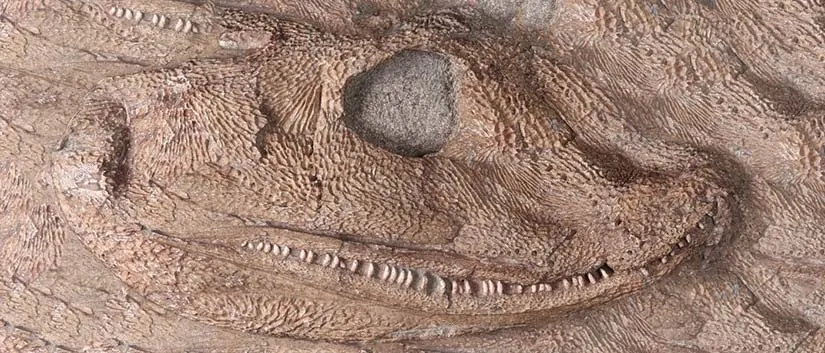Fossil skull sheds new light on transition from water to land
The first 3D reconstruction of the skull of a 360 million-year-old near-ancestor of land vertebrates has been created by scientists from the Universities of Bristol and Cambridge, UK. The 3D skull, which differs from earlier 2D reconstructions, suggests such creatures, which lived their lives primarily in shallow water environments, were more like modern crocodiles than previously thought. The researchers applied high-resolution X-ray computed tomography (CT) scanning to several specimens of Acanthostega gunnari, one of the 'four-footed' vertebrates known as tetrapods which invaded the land during one of the great evolutionary transitions in Earth's history, 380-360 million years ago. Tetrapods evolved from lobe-finned fishes and display a number of adaptations to help them survive on land.
An iconic fossil species, Acanthostega gunnari is crucial for understanding the anatomy and ecology of the earliest tetrapods. However, after hundreds of millions of years in the ground fossils are often damaged and deformed. No single specimen of Acanthostega preserves a skull that is complete and three-dimensional which has limited scientists' understanding of how this key animal fed and breathed -- until now.
Using special software, the Bristol and Cambridge researchers 'digitally prepared' a number of Acanthostega specimens from East Greenland, stripping away layers of rock to reveal the underlying bones.
They uncovered a number of bones deep within the skull, including some that had never before been seen or described, resulting in a detailed anatomical description of the Acanthostega skull.
Once all of the bones and teeth were digitally separated from each other, cracks were repaired and missing elements duplicated. Bones could then be manipulated individually in 3D space. Using information from other specimens, the bones were fitted together like puzzle pieces to produce the first 3D reconstruction of the skull of Acanthostega, with surprising results.
Lead author, Dr Laura Porro, formerly of Bristol's School of Earth Sciences and now at the Royal Veterinary College, said: "Because early tetrapods skulls are often 'pancaked' during the fossilization process, these animals are usually reconstructed having very flat heads. Our new reconstruction suggests the skull of Acanthostega was taller and somewhat narrower than previously interpreted, more similar to the skull of a modern crocodile."
The researchers also found clues to how Acanthostega fed. The size and distribution of its teeth and the shape of contacts between individual bones of the skull (called sutures) suggest Acanthostega may have initially seized prey at the front of its jaws using its large front teeth and hook-shaped lower jaw.
Co-author, Professor Emily Rayfield, also from Bristol's School of Earth Sciences, said: "These new analyses provide fresh clues about the evolution of the jaws and feeding system as the earliest animals with limbs and digits began to conquer the land."
The researchers plan to apply these methods to other flattened fossils of the earliest tetrapods to better understand how these early animals modified their bones and teeth to meet the challenges of living on land.
Digital models of the original fossils and the 3D reconstruction are also useful in scientific research and education. They can be accessed by researchers around the world, without risking damage to fragile original fossils and without scientists having to travel thousands of miles to see original specimens. Furthermore, digital models and 3D printouts can be easily and safely handled by students taking courses and by the public during outreach events.


%20(1).webp)






